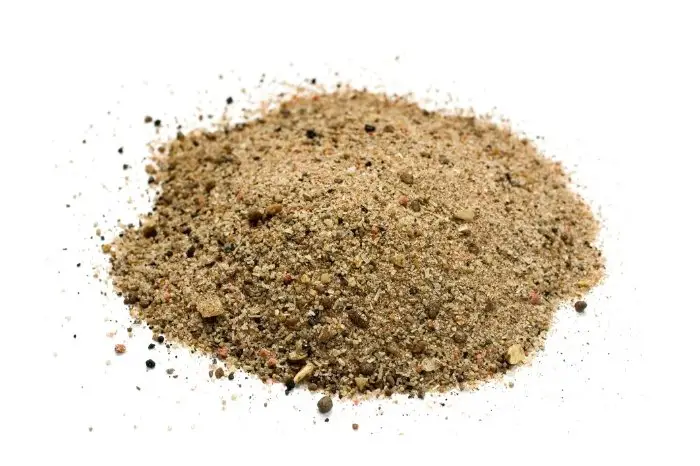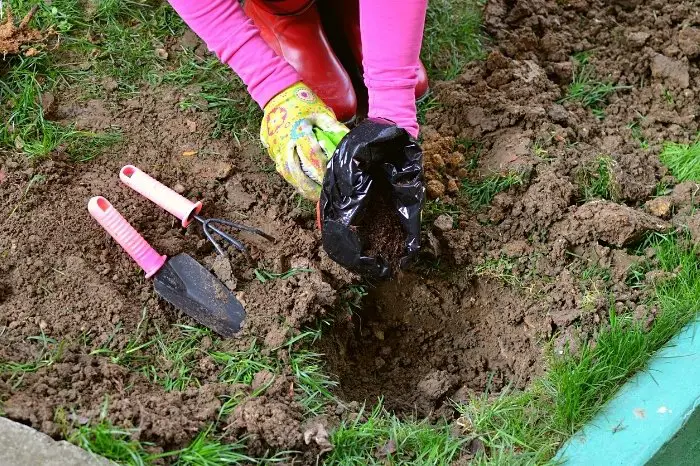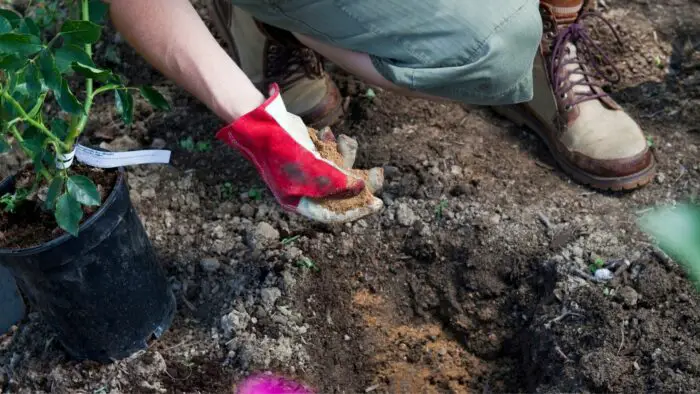Last Updated on March 16, 2023
How much bone meal per tomato plant? This article will help you determine how much bone meal you should give per tomato plant and how to effectively use bone meal for tomatoes.
Tomatoes are heavy feeders and require a lot of nutrients. Bone meal is one of the easiest ways to give an extra boost to your tomato’s health and growth. Let’s take a closer look at using bone meal for tomatoes.
Bone Meal Nutrition Facts
Bone meal made from animal bones is rich in phosphorus, calcium, and nitrogen. It can be used as fertilizer for tomato plants. Both fresh and dried bone meals are available on the market; however, make sure that you buy organic bone meals without any chemical fertilizers or fillers added.
Fresh bone meal contains a high amount of water (moisture) which can cause problems if not removed before storage. The dried form provides more nutrient content than the fresh form because it has fewer moisture contents; thus, making it easy to store for a long time without spoiling.
One tablespoon of bone meal provides seven grams of phosphorus and nine grams of calcium, which equals 13% of the recommended daily value (RDA) for phosphorus and 18% RDA for calcium.
Bone meal supplies important nutrients that help encourage health in plants because it contains both phosphorus and calcium. The ratio between these two minerals can affect how each nutrient contributes to your plants’ overall health. Using too much phosphorus can cause growth problems, especially for seedlings. Excessive phosphorus can stunt a plant’s root growth and interfere with how well a plant absorbs other nutrients.
Bone meal is an organic fertilizer that contains a high amount of calcium, an essential nutrient for promoting strong cell wall development in new blossoms and fruits. Calcium also helps fruit to mature properly after harvest.
You should use bone meal as soon as possible after opening the package because the moisture from the soil or environment may cause it to become moldy or change color over time.
Is Bone Meal Good for Tomatoes?
Bone meal is good for tomato plants. It contains a high amount of calcium that helps in fruit formation. It contains nitrogen and phosphorus which are required by plants to produce chlorophyll while the growing stage and calcium during the fruiting stage.
Please note: you can add bone meal directly to the soil without any preparation or cooking process. However, if you want it cooked before adding it to the soil, you can add it to the compost because raw bone meal contains a high amount of ammonia that can burn roots once mixed with soil.
Burpee Bone Meal Fertilizer | Add to Potting Soil
How Much Bone Meal for Tomatoes?
Now that we know the benefits of this organic fertilizer to tomatoes, how much bone meal per tomato plant?
Use 3 pounds of fresh or 1 pound of dried bone meals for 100 square feet of garden space. For example, how much bone meal per 10 tomato plants? You will need 1/2 pound of bone meal per tomato plant.
Can You Add Too Much Bone Meal?
It is possible to add too much bone meal and hurt your crops. Do not add too much bone meal to the soil because it will cause phytotoxicity in tomato plants. Excess amounts of nitrogen contained in it can damage leaves and slow down fruit formation or growth.
You should avoid adding more than 0.25% nitrogen level to the soil because even if it contains plenty of phosphorus, calcium, magnesium, zinc, copper, sulfur, and other nutrients, an excess amount of nitrogen will burn the roots after absorption by the soil.
Bone Meal for Tomatoes Benefits
Ways to use bone meal for tomato plants:
- To boost the health of tomato plants, you can give it every week during the first couple of months of growth. You can also use it as transplanting fertilizer or seedling fertilizers at half the rate of how much you would give to mature plants later on. Bone meal works well for this purpose because it is rich in phosphorus which helps with root formation and healthier stem structure.

- Bone meal gives a calcium source that is beneficial for both humans and soil microbes. Calcium accelerates the decomposition speed of dead materials, thus increasing nutrient availability to growing tomatoes faster than compost alone. Organic matter content also improves due to the presence of calcium in bone meal.
Can You Add Bone Meal After Planting?
Bone meal can be added after planting tomatoes if it is dry. However, do not add bone meal to the soil until you are ready to transplant seedlings into them because tomato plants cannot grow properly when nitrogen levels are too high. Especially for seeds that have just emerged, adding too much bone meal will result in yellow leaves or stunted growth.
If you want to use bone meal for tomatoes as fertilizer, it is better to mix organic fertilizers with soil before planting tomatoes.
Bone meal can be used with other organic fertilizers. For example, blood meal, cottonseed meal, and kelp extracts. This combination will provide essential nutrients needed by growing tomatoes. If bone meal is added directly into the garden or container without mixing with other ingredients first, soil microbes may not be able to absorb them properly which can lead to loss of nutrients in time.
Bone meal works best when mixed with compost piles because they allow microbes to break down the materials slowly over time.
You should always water your tomato plants after adding any kind of fertilizers into the soil because soluble nitrogen releases quickly into roots which affects how well it absorbs water. Watering your plants first will allow them to take up the nutrients gradually without getting too much nitrogen.

Using Sugar, Epsom Salt, and Bone Meal for Tomatoes
You may be wondering how else you can use bone meal for your tomatoes. I’ve found that the use of bone meal, along with sugar and Epsom salt works very well. These three are a good trio because the sugar adds sweetness to your tomatoes, the Epsom salts add both sulfur and magnesium and the bone meal adds phosphorus.
To plant your tomatoes, you’ll need to make a hole larger than you usually would for your tomatoes. Then you’ll need to add a cup of bone meal and a cup of sugar, along with a reasonable amount of mulch. Mix them and place them in your hole, evenly distributing them in the soil.
Carefully place your tomato plant into the soil; be sure to bury it reasonably deep. Once planted, add around a cup of Epsom salts on top and mix them into the top of your soil using your hands. Finally, water your tomato plants with a good amount of water – and your tomatoes are ready to go.
Disadvantages of Bone Meal
We’ve already looked at the benefits of using bone meal for your tomato plants, but you may be wondering if there are any disadvantages. While there aren’t too many negatives, there are a few that you may want to be aware of. Let’s take a closer look.
You can only use bone meal in soils below 7 on the pH scale. This may not be ideal. However, a good alternative is rock phosphate, which we’ll be taking a look at later in this article.
If you’re looking for a quick fix, then this probably isn’t the best choice for you, as it’s a fertilizing choice that releases slowly.
If used too much, overfertilization can occur. If this happens, problems may arise for your tomato plants such as yellowing leaves. It can also lead to deficiencies in other nutrients, like zinc and iron.
If not used correctly, the smell can attract unwanted wildlife. However, as long as it’s adequately mixed in, this should not be a problem.
Bone meal is only a good source of phosphorus, so you’ll need to use other fertilizers too, to ensure your tomato plants are receiving all of the nutrients they need.
Rock Phosphate vs Bone Meal
Earlier, we mentioned rock phosphate, which is a great alternative to bone meal, if you’d prefer. However, there are quite a few differences between the two. Let’s take an in-depth look at the two.
They’re similar in that they both contain phosphorus. However, that is where the similarities start and end. The differences between the two are that for the short supply of phosphorus, bone meal is best, whereas, for a long-term supply, phosphorus is best, as it’s slower.
Another main difference between the two is the price. Bone meal starts at around $13 per lb, whereas rock phosphate starts at around $30 per lb. So if you’re looking for a more affordable option, it’s best to use bone meal.
Rock phosphate works best on flowers and other leafy plants, whereas bone meal works best on rooted plants, such as carrots and onions. However, you can choose to use both together, if you’d prefer – and reap the benefits of both.
Final Thoughts: Bone Meal for Tomatoes
Bone meal for tomatoes is beneficial in most cases. Adding too much nitrogen to the soil will hurt plants, although you can add it if your plants are mature enough. You should only use bone meal after preparing the soil with compost or manure and not mix it directly into planting holes.
It s evident that bone meal provides your tomatoes with plenty of benefits like boosting up the nutrient content of the soil, by adding calcium source which creates healthier stem structure and roots.
FAQs
How should you mix bone meals for best results?
You should not mix it directly with planting holes because adding too much phosphorus can affect how healthy tomatoes grow even if they are combined with other organic fertilizers. Therefore, it is better to prepare compost piles or manure before mixing into the soil or using as transplant fertilizer after seeds have germinated and grown some roots.
When should I start fertilizing my tomato plants?
Bone meal should be added to the soil when the first set of tomatoes starts growing. Wait until your plant is about 6 - 8 inches tall before adding bone meal fertilizer. If you add it too early, it will affect how healthy or how tall they grow.

Lory is an avid gardener who loves spending time outdoors. She is passionate about using her green thumb to create beautiful, lush gardens for her friends and family. She finds joy in tending to her garden, trimming plants, and cultivating new species. She loves to share her knowledge and experience with others who have a similar enthusiasm for gardening. Lory is a true nature enthusiast who loves to share her enthusiasm for the outdoors with all who meet her.


